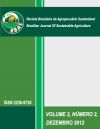THE CONTRIBUTION OF STRAW FROM DIFFERENT SOURCES ON YIELD OF CORN AND COWPEA, ON NO TILLAGE SYSTEM
DOI:
https://doi.org/10.21206/rbas.v2i2.171Abstract
The success of no tillage system is directly related with the remaining of crop residues on soil surface, the quality and quantity of straw and its mineralization promoting recycling of the nutrients. The aim of this study was to evaluate the contribution of straw from spontaneous vegetation, millet (Pennisetum americanum sin. tiphoydes), brachiaria (Brachiaria brizantha); sorghum forage (Sorghum bicolor L Moench), and the straw from conventional tillage, on corn and cowpea grain yield under two minimum tillage systems: SPD1 (corn following cowpea) and SPD2 (cowpea following corn), under the semiarid conditions of the Quixada County, Ceara, Brazil, during 2008 and 2009. It was evaluated also the period of duration of the straw on soil surface and the rate of decomposition of the straw from corn and cowpea. The straw yield from spontaneous vegetation was around 6.0 t ha-1 similar to the yield of the others soil biomass covers in both SPD1 and SPD2 minimum tillage systems. The degradation of the vegetal residues to the soil at the end of two years of evaluation was greater when the dry matter from cowpea was used as straw when compared with the straw from corn. The grain yield of corn from the different death cover was significantly lower than the conventional in 2008 and 2009. The cowpea yield was higher from conventional planting than from than the minimum tillage with different straw covers.Downloads
Downloads
Published
2012-12-01
How to Cite
Júnior Régis Batista Cysne, Ciro Miranda Pinto, Olienaide Ribeiro de Oliveira Pinto, & João Bosco Pitombeira. (2012). THE CONTRIBUTION OF STRAW FROM DIFFERENT SOURCES ON YIELD OF CORN AND COWPEA, ON NO TILLAGE SYSTEM. Brazilian Journal of Sustainable Agriculture, 2(2). https://doi.org/10.21206/rbas.v2i2.171
Issue
Section
Artigos
License
1. Proposta de Política para Periódicos de Acesso Livre
Autores que publicam nesta revista concordam com os seguintes termos:
Autores mantém os direitos autorais e concedem à revista o direito de primeira publicação, com o trabalho simultaneamente licenciado sob a Licença Creative Commons Attribution que permite o compartilhamento do trabalho com reconhecimento da autoria e publicação inicial nesta revista.











